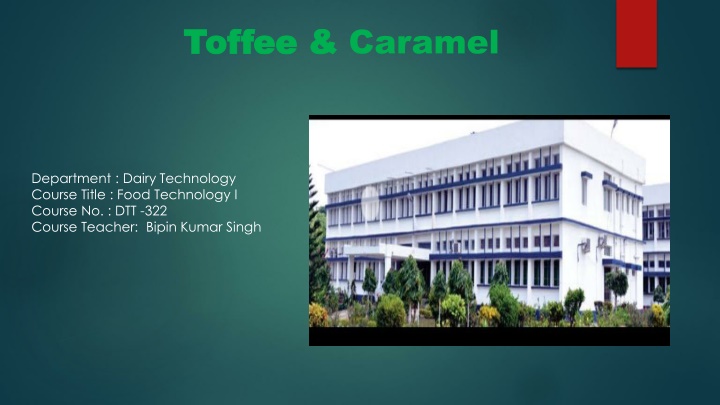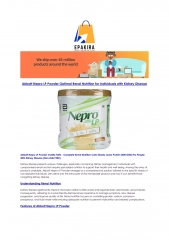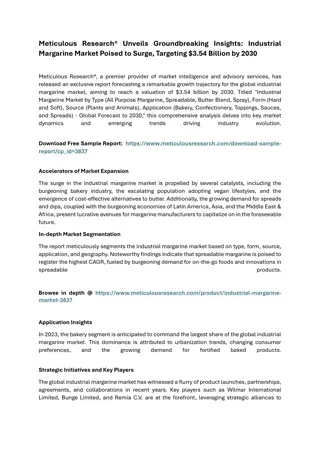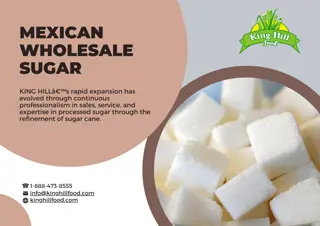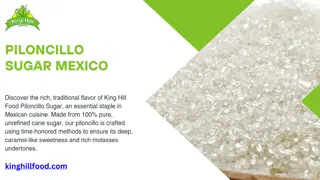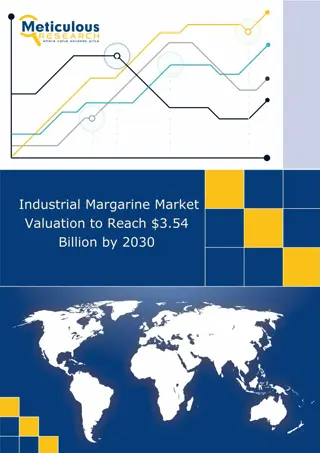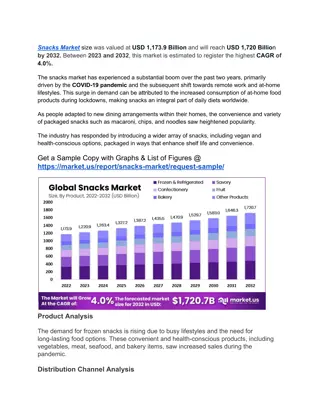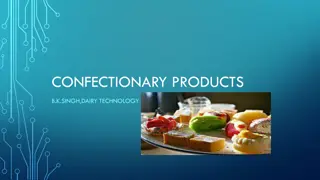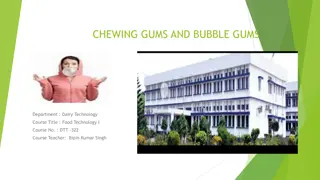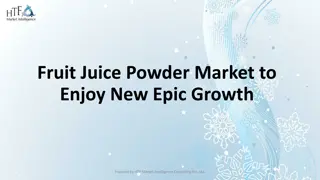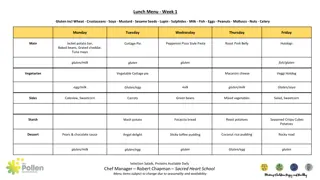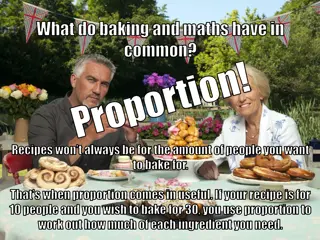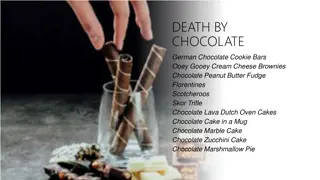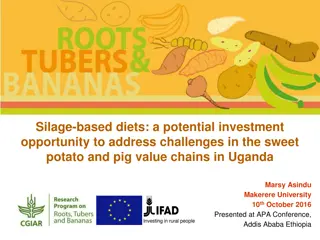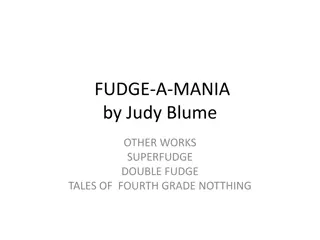Discovering Toffee, Caramel, and Fudge: A Sweet Exploration in Confectionery
Exploring the world of toffee, caramel, and fudge reveals a sweet journey through confectionery delights. From the process of creating toffee's hard crack stage to the versatile nature of caramels, and the smooth creamy consistency of fudge, each confection offers a unique taste and texture. Discover the chemistry behind these beloved treats and indulge in their delicious variations and applications in the confectionery industry.
Download Presentation

Please find below an Image/Link to download the presentation.
The content on the website is provided AS IS for your information and personal use only. It may not be sold, licensed, or shared on other websites without obtaining consent from the author.If you encounter any issues during the download, it is possible that the publisher has removed the file from their server.
You are allowed to download the files provided on this website for personal or commercial use, subject to the condition that they are used lawfully. All files are the property of their respective owners.
The content on the website is provided AS IS for your information and personal use only. It may not be sold, licensed, or shared on other websites without obtaining consent from the author.
E N D
Presentation Transcript
Toffee & Toffee & Caramel Department : Dairy Technology Course Title : Food Technology I Course No. : DTT -322 Course Teacher: Bipin Kumar Singh
Toffee Toffee is a confection made by caramelizing sugar (creating inverted sugar) along with butter, and occasionally flour. The mixture is heated until its temperature reaches the hard crack stage of 149 to 154 C (300 to 310 F). While being prepared, toffee is sometimes mixed with nuts or raisins. or molasses
Toffee Toffee is versatile candy products and constitute large part of the confectionery industry. Toffee is a products that do not contain milk solids and prepared by using brown sugar, glucose syrup and fat mainly butter fat. They appear in many aspects quite similar to butterscotch but differ in the intensity of heating. Processing of milk led to the inclusion of milk solids in toffee formulation and resultant product contains slightly higher moisture in the range of 8 - 9%.
Caramel Caramel may be found in a range of textures, colors, flavors and products. This common confection may be consumed alone as or in combination with chocolate, nougat, marshmallows, nuts and other inclusions. Some applications include consumption, for depositing into chocolate shells, as ice cream toppings and ingredient in other confections or desserts. It is a medium to dark-orange confectionery product made by heating a variety of sugars. It can be used as a flavoring in puddings and desserts, as a filling in bonbons, or as a topping for ice cream and custard. caramels wrapped for
Fudge Fudge is another type of confectionary product which resemble to caramel or toffee but differs in the processing as in it sugar crystals are developed during the cooking. Normally it contains more sugar and milk as compared to toffee or caramel. It is made by mixing sugar, butter and milk, heating it to the soft-ball stage at 240 F, and then beating the mixture while it cools so that it acquires a smooth, creamy consistency. In texture, this crystalline candy falls in between fondants and hard caramels. Fruits, nuts, chocolate, caramel, candies, sweets and other flavors are sometimes added either inside or on top. A recent trend has been to create novel flavors of fudge, giving vibrant visual appeal at the same time. Fudge is often bought as a gift from a gift shop in tourist areas and attractions.
Chemistry of Fudge One of the most important attributes of fudge is its texture. The end- point temperature separates hard caramel from fudge. The higher the peak temperature, the more sugar is dissolved and the more water is evaporated, resulting in a higher sugar-to-water ratio. Before the availability of cheap and accurate thermometers, cooks would use the ice water test, also known as the cold water test, to determine the saturation of the confection. Fudge is made at the "soft ball" stage, which varies by altitude and ambient humidity from 235 F (113 C) to 240 F (116 C). Butter is added, and then the fudge is cooled and beaten until it is thick and small sugar crystals have formed. The warm fudge is sometimes poured onto a marble slab to be cooled and shaped.
Variants and applications of Toffee A popular variant in the US is English toffee, which is a very buttery toffee often made with almonds. It is available in both chewy and hard versions. Heath bars are a brand of confection made with an English toffee core. Although named English toffee it bears little resemblance to the wide range of confectionery known as toffee currently available in the United Kingdom. However, one can still find this product in the UK under the name "butter crunch." Conversely, in Italy they are known as "mou candies".[1] Another variant is honeycomb toffee, which is an aerated version with bubbles introduced by adding baking soda and vinegar while mixing. These react to form carbon dioxide, which is trapped in the highly the UK and Canada, the best known honeycomb confection is the Crunchie bar. A similar Australian chocolate bar is the Violet Crumble. In New Zealand, vanilla ice cream with pieces of honeycomb in it is called hokey pokey. A particular application of toffee is in toffee apples, sometimes called candy apples, which are apples coated with hard toffee mounted on sticks. Toffee apples are similar to taffy apples and caramel apples, which are both covered in caramel. Toffee used in confectionery can be mixed with many different ingredients to produce a variety of flavors: rum and butter, chocolate covered, vanilla and chocolate, rum and raisin, raspberry, and honeycomb. viscous mixture. In
Nutritional facts of Toffee Vitamin A %Daily Value* 1% Total Fat3.9 g 6% Calcium 0% Saturated fat2.5 g 12% Vitamin D Polyunsaturate d fat0.1 g 0% Monounsaturat ed fat1.1 g Vitamin B-12 0% Cholesterol12 mg 4% Sodium16 mg 1% Vitamin C Iron Vitamin B-6 Magnesi um 0% 0% Potassium6 mg 0% Total Carbohydrate8 g 3% 0% Dietary fiber0 g 0% Sugar8 g 0% Protein0.1 g 0%
Technology For Manufacture of Toffee Toffee were prepared on fuel or gas fired pans, electric or steam boiling pans. These pans were fitted with a stirrer and scrappers which are thrown out ward by centrifugal forces to remove the cooking toffee from every part of the heating surfaces. Now a days continuous process is also applied in some plant.
Continuous Toffee plant consists of the following parts. Auto feeder Pre heater Blender Cooker
Manufacturing process of Toffee Hydrogenated vegetable fat. Butter Melting To 65degC Emulsifier Sugar Emulsification Corn. Water Cooking with continuous stirring Syrup Milk solid (evaporated milk, condensed Heating to 115-120 milk/SMP) cooling
Addition of vanillin /flavour spreading & decomposition or slab formation Cooling Packaging and storage
Pre - mixing Mixing of all ingredients are performed separately for fat phase and aqueous phase. Fat phase preparation of butter /milk fat is mixed with melted vegetable fat and emulsifier at designed speed to mix the ingredients. Sugar is dissolved in water, and mixed with milk solids and melted corn syrup.
Emulsification Aqueous and fat phases are emulsified by using high speed mixer. Emulsification adequate quantity to get the desired texture and other quality attribute in the finished product. Emulsifier and milk protein assists in Emulsification. must be in
Cooking Cooking of toffee at designed temperature is essential to develop proper texture and organoleptic quality specially the flavour and colour. Cooking temperature also affects the final moisture and it influences the texture and chewiness. Toffee cooked to 125 - 130 moisture. Cooking at under or over temperature may cause some defects in finished products. Higher cooking temp. of upto 145 with these products meant for hot climate. These are less likely to grain (crystallize) during storage. contains around 6 - 8% must be employed
Cooling & depositing The transferred to depositor or forming unit where both cooling as well as shaping takes place . cooked mixture is The cooling is essential to prevent over - cooking of toffee.
